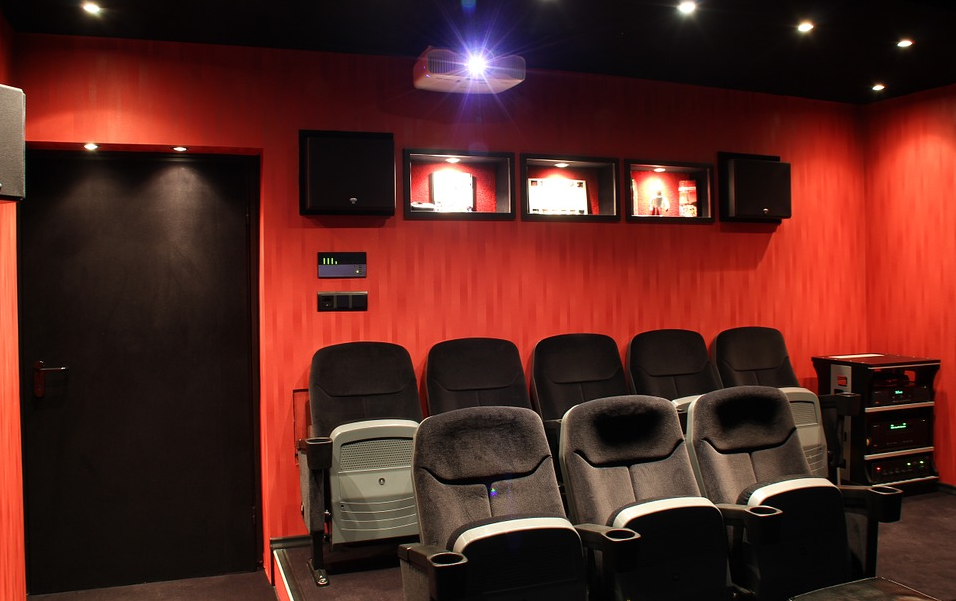Room Flow
When designing any room, it is essential to consider room flow. When interior designers use this term, they are generally referring to two aspects of room flow: aesthetic flow and functional flow.
Aesthetic Flow
Aesthetic flow simply refers to how aesthetically pleasing a room is when you scan it with your eyes. Do the colors, shapes and patterns of the room tie nicely together, allowing your eyes to continue scanning a room uninterrupted? Are there eyesores, mismatched pieces, or objects that just don't seem to fit well? Ideally, no matter what room you are planning for, you want the end result to be one that flows well and is pleasing to look at. A good place to start when designing any room is to dedicate a focal point and then design around that. With a home theater, that part is more or less already done, since the focal point will obviously be the TV or projection screen.
From there you may want to consider the size of the screen itself. If you have a very large empty wall, a larger TV or screen is best. Depending on your floor space available, you can choose from standing or mounted options. TV stands are nice because they provide added storage as well as an easy hiding spot for unsightly cords and cables. It is essential to remember to allow for adequate ventilation of all of your devices wherever you choose to place them. Certain sound devices in particular often require constant ventilation to avoid becoming too hot.
If you want a very sleek and modern feel, a large flat-screen may suit you best. If you are going for a more old-school, true-theater experience, a projector and a high quality screen may better suit your needs.
Functional Flow
Functional flow refers to how well the room serves its users for its intended purposes. Are your power outlets all properly grounded, or do they share a circuit with other large appliances? When designing a theater, it is especially important to consider functionality during each step of planning in order to achieve the most efficient results possible. If you plan on using your home theater mostly in the dark, you may want to consider rope lighting or dimmer switches to allow for just enough light to see when walking. When planning the functionality of your theater, it is not a bad idea to consult with an electrician like All American Air & Electric, Inc. They can help you design your room in a way that is efficient, safe for your devices, and most importantly safe for you. A lot of tech companies like Best Buy even offer home-theater installation services as well. They can assist you with every step of your planning as well as theater installation. Also, in the case of the home theater, it is important to keep in mind your network access points when designing your room.
Room Acoustics & Electrical Considerations
Another hugely important functional aspect of the home theater to consider is room acoustics. All home theaters will have some type of surround sound device. There are endless options to choose from, so again, you may want to research this further with your specific room in mind, or consult expert installers to determine which option is the best fit for you.
One aspect of acoustics is controlling the way sound is reflected off hard surfaces and absorbed by softer ones. Additionally, you may find that positioning sub-woofers closer to walls or corners will typically give you a stronger sounding bass. Experiment with speaker placement until you find what works best with your space. Location can make all the difference when it comes to room acoustics.
Electrical considerations are where most people get stumped when it comes to planning their home theater. Again, doing some research ahead of time and consulting with a professional electrician beforehand are both excellent ideas. Some things you can do on your own include purchasing a power bar with surge protection. This will protect your home and devices as well. You can also measure your cord space once you have decided on your layout so you can know the length of video and audio cables you need to purchase. Toolong of cables can create a mess, and tooshort of cables, well, won't work.
TV/Projectors
Flat screens and projector screens can both be a great choice for a home theater, but there is so much growing technology out there, and it can be hard to know where to start.
As mentioned before, if you go with a projector, the higher quality screen you invest in, the better reflection and image-brightness you will achieve. The projector itself is classified by how many lumens it projects. Lumens refers to light output. The darker the room, the less lumens you will need and vice versa.
Like projectors, flat screens also come in a variety of classifications, largely based on room brightness. Best Buy recommends a plasma or OLED screen for a dark or dim room, and an LED or LCD screen for a brighter room. Additionally, GeekSquad members will inform you that a 50" or larger screen is highly recommended, with the best resolutions options on the market being the 4K Ultra HD.
Now that you have a better understanding of what types of factors you need to consider when designing your home theater, you can start planning! Remember to always ask lots of questions, comparison shop, and ask stores and manufacturers about competitor price matching and discounts and promotions. Consulting with an electrician in your area and installation service providers may also prove to be well-worth the money. In no time, you’ll have the home theater experience you always dreamed of!











Tidak ada komentar:
Posting Komentar